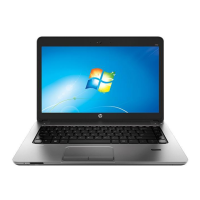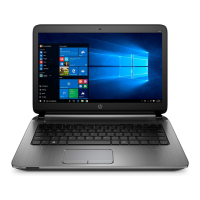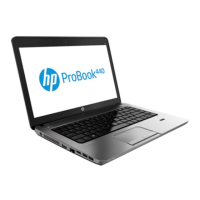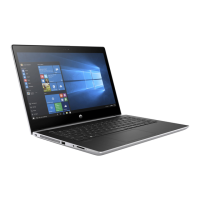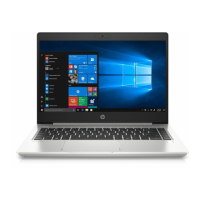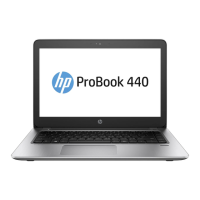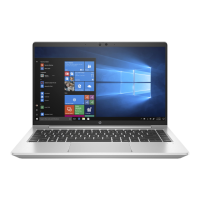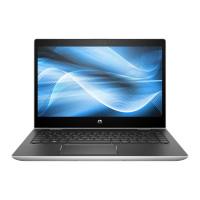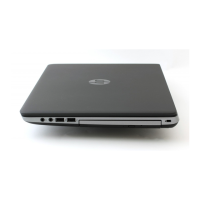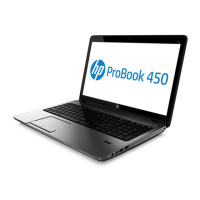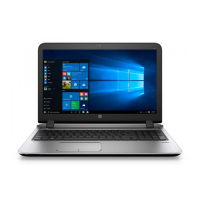Do you have a question about the HP ProBook 440 G3 and is the answer not in the manual?
Details about CPU options and the chipset integrated with the processor.
Information on integrated UMA graphics and optional discrete graphics cards.
Specifications for HD and FHD display panels, including resolution and aspect ratio.
Details on memory module slots and supported RAM configurations up to 16 GB.
Specifications for M.2 SSD and 7-mm SATA hard drives.
Covers audio/visual components, Ethernet, wireless modules, media card slots, and ports.
Details on HP Advanced Keyboard types and Touchpad gestures.
Information on AC adapter wattages, power cord types, and battery specifications.
Details on integrated fingerprint reader and security lock options.
Lists preinstalled operating systems and restore media types.
Identifies USB 3.0 ports, HDMI, external monitor port, RJ-45, and security slot.
Identifies power connector, battery light, vent, USB charging port, and audio combo jack.
Identifies WLAN/WWAN antennas, microphones, webcam light, and webcam.
Overview of touchpad, indicator lights, buttons, and keyboard keys.
Identifies battery bay, vents, and service door access.
Lists and describes major internal components with spare part numbers.
Details display bezel, panel, hinges, webcam, and microphone modules.
Lists display/webcam cables, power button cables, and plastics kits.
Lists M.2 SSDs and 2.5-inch SATA hard drives with specifications.
Details AC adapters, power cords for different regions, and rubber/screw kits.
Lists required tools such as screwdrivers for disassembly and reassembly.
General precautions for handling computer parts during service.
Guidelines for preventing ESD damage to components during service.
Overview of procedures for replacing customer self-repairable parts.
Step-by-step instructions for removing and replacing the notebook battery.
Instructions for removing the service door to access internal components.
Detailed steps for removing and replacing the computer's hard drive.
Instructions for removing and installing memory modules in the computer.
Steps for removing and replacing the wireless LAN/Bluetooth combo card.
Instructions for removing and installing the M.2 solid-state drive.
Step-by-step guide for removing and replacing the computer keyboard.
Detailed steps for removing and replacing the top cover assembly.
Instructions for removing and installing the fingerprint reader assembly.
Steps for removing and replacing the power button board assembly.
Instructions for removing and replacing the function board.
Steps for removing and replacing the USB/audio/card reader board.
Instructions for removing and installing the computer's internal cooling fan.
Steps for removing and replacing the battery connector cable.
Detailed instructions for removing and replacing the computer's main system board.
Steps for removing and replacing the Real-Time Clock (RTC) battery.
Instructions for removing and installing the speaker assembly.
Steps for removing and replacing the heat sink assembly for cooling.
Instructions for removing and replacing the entire display assembly.
Steps for removing and replacing the power connector and cable.
Guide to navigating and using Computer Setup for system configuration.
Instructions for restoring BIOS settings to their original factory defaults.
Information on checking for and downloading BIOS updates from HP.
Step-by-step guide to download BIOS updates from HP support.
Explanation of MultiBoot functionality and boot device order management.
Information on HP Sure Start technology for BIOS protection.
Guide to navigating and using Computer Setup for system configuration.
Instructions for restoring BIOS settings to their original factory defaults.
Information on checking for and downloading BIOS updates from HP.
Step-by-step guide to download BIOS updates from HP support.
How to dynamically select boot devices using the F9 prompt.
Information on configuring Trusted Platform Module (TPM) settings in BIOS.
Information on HP Sure Start technology for BIOS protection.
Guide to navigating and using Computer Setup for system configuration.
Instructions for restoring BIOS settings to their original factory defaults.
Information on checking for and downloading BIOS updates from HP.
Step-by-step guide to download BIOS updates from HP support.
How to dynamically select boot devices using the F9 prompt.
Information on configuring Trusted Platform Module (TPM) settings in BIOS.
Information on HP Sure Start technology for BIOS protection.
Guide to navigating and using Computer Setup for system configuration.
Instructions for restoring BIOS settings to their original factory defaults.
Information on checking for and downloading BIOS updates from HP.
Step-by-step guide to download BIOS updates from HP support.
Steps to launch the hardware diagnostic tool from BIOS.
Guide to download the diagnostic tool onto a USB drive.
Procedures for creating system recovery media and backups.
Methods for system recovery using Windows tools or recovery media.
Instructions for using f11 recovery tools for original hard drive image recovery.
Steps for recovery using Windows 7 installation media if recovery media fails.
Guidance on creating backups and system repair media.
Methods for system recovery using Windows tools or f11 recovery.
Steps for recovery using Windows 8.1 installation media.
Methods for creating HP Recovery media and using Windows tools.
Options for system recovery using HP Recovery Manager or media.
Instructions for removing the HP Recovery partition to free up space.
Guidance on creating restore media and system backups.
Steps for backing up computer files to external drives or discs.
Methods for restoring the computer to its original factory state.
How to create and use a USB recovery disk for Ubuntu.
Process for reformatting and reinstalling the Ubuntu operating system.
Detailed specifications for computer dimensions, weight, power, and environmental conditions.
Technical details for the 35.6-cm (14.0-in) display, including resolution and brightness.
Specifications for various capacities of SATA hard drives.
Specifications for 128-GB and 256-GB M.2 Solid-state drives.
Explains usage, data storage, and write protection for various nonvolatile memory types.
Steps to reset BIOS security settings and securely erase data.
Information on HP Sure Start technology for BIOS protection.
General specifications for power cord length, current capacity, and connector type.
Lists specific accreditation agencies and cable requirements per country.
Guidance on proper disposal and recycling of batteries.
Details about CPU options and the chipset integrated with the processor.
Information on integrated UMA graphics and optional discrete graphics cards.
Specifications for HD and FHD display panels, including resolution and aspect ratio.
Details on memory module slots and supported RAM configurations up to 16 GB.
Specifications for M.2 SSD and 7-mm SATA hard drives.
Covers audio/visual components, Ethernet, wireless modules, media card slots, and ports.
Details on HP Advanced Keyboard types and Touchpad gestures.
Information on AC adapter wattages, power cord types, and battery specifications.
Details on integrated fingerprint reader and security lock options.
Lists preinstalled operating systems and restore media types.
Identifies USB 3.0 ports, HDMI, external monitor port, RJ-45, and security slot.
Identifies power connector, battery light, vent, USB charging port, and audio combo jack.
Identifies WLAN/WWAN antennas, microphones, webcam light, and webcam.
Overview of touchpad, indicator lights, buttons, and keyboard keys.
Identifies battery bay, vents, and service door access.
Lists and describes major internal components with spare part numbers.
Details display bezel, panel, hinges, webcam, and microphone modules.
Lists display/webcam cables, power button cables, and plastics kits.
Lists M.2 SSDs and 2.5-inch SATA hard drives with specifications.
Details AC adapters, power cords for different regions, and rubber/screw kits.
Lists required tools such as screwdrivers for disassembly and reassembly.
General precautions for handling computer parts during service.
Guidelines for preventing ESD damage to components during service.
Overview of procedures for replacing customer self-repairable parts.
Step-by-step instructions for removing and replacing the notebook battery.
Instructions for removing the service door to access internal components.
Detailed steps for removing and replacing the computer's hard drive.
Instructions for removing and installing memory modules in the computer.
Steps for removing and replacing the wireless LAN/Bluetooth combo card.
Instructions for removing and installing the M.2 solid-state drive.
Step-by-step guide for removing and replacing the computer keyboard.
Detailed steps for removing and replacing the top cover assembly.
Instructions for removing and installing the fingerprint reader assembly.
Steps for removing and replacing the power button board assembly.
Instructions for removing and replacing the function board.
Steps for removing and replacing the USB/audio/card reader board.
Instructions for removing and installing the computer's internal cooling fan.
Steps for removing and replacing the battery connector cable.
Detailed instructions for removing and replacing the computer's main system board.
Steps for removing and replacing the Real-Time Clock (RTC) battery.
Instructions for removing and installing the speaker assembly.
Steps for removing and replacing the heat sink assembly for cooling.
Instructions for removing and replacing the entire display assembly.
Steps for removing and replacing the power connector and cable.
Guide to navigating and using Computer Setup for system configuration.
Instructions for restoring BIOS settings to their original factory defaults.
Information on checking for and downloading BIOS updates from HP.
Step-by-step guide to download BIOS updates from HP support.
Explanation of MultiBoot functionality and boot device order management.
Information on HP Sure Start technology for BIOS protection.
Guide to navigating and using Computer Setup for system configuration.
Instructions for restoring BIOS settings to their original factory defaults.
Information on checking for and downloading BIOS updates from HP.
Step-by-step guide to download BIOS updates from HP support.
How to dynamically select boot devices using the F9 prompt.
Information on configuring Trusted Platform Module (TPM) settings in BIOS.
Information on HP Sure Start technology for BIOS protection.
Guide to navigating and using Computer Setup for system configuration.
Instructions for restoring BIOS settings to their original factory defaults.
Information on checking for and downloading BIOS updates from HP.
Step-by-step guide to download BIOS updates from HP support.
How to dynamically select boot devices using the F9 prompt.
Information on configuring Trusted Platform Module (TPM) settings in BIOS.
Information on HP Sure Start technology for BIOS protection.
Guide to navigating and using Computer Setup for system configuration.
Instructions for restoring BIOS settings to their original factory defaults.
Information on checking for and downloading BIOS updates from HP.
Step-by-step guide to download BIOS updates from HP support.
Steps to launch the hardware diagnostic tool from BIOS.
Guide to download the diagnostic tool onto a USB drive.
Procedures for creating system recovery media and backups.
Methods for system recovery using Windows tools or recovery media.
Instructions for using f11 recovery tools for original hard drive image recovery.
Steps for recovery using Windows 7 installation media if recovery media fails.
Guidance on creating backups and system repair media.
Methods for system recovery using Windows tools or f11 recovery.
Steps for recovery using Windows 8.1 installation media.
Methods for creating HP Recovery media and using Windows tools.
Options for system recovery using HP Recovery Manager or media.
Instructions for removing the HP Recovery partition to free up space.
Guidance on creating restore media and system backups.
Steps for backing up computer files to external drives or discs.
Methods for restoring the computer to its original factory state.
How to create and use a USB recovery disk for Ubuntu.
Process for reformatting and reinstalling the Ubuntu operating system.
Detailed specifications for computer dimensions, weight, power, and environmental conditions.
Technical details for the 35.6-cm (14.0-in) display, including resolution and brightness.
Specifications for various capacities of SATA hard drives.
Specifications for 128-GB and 256-GB M.2 Solid-state drives.
Explains usage, data storage, and write protection for various nonvolatile memory types.
Steps to reset BIOS security settings and securely erase data.
Information on HP Sure Start technology for BIOS protection.
General specifications for power cord length, current capacity, and connector type.
Lists specific accreditation agencies and cable requirements per country.
Guidance on proper disposal and recycling of batteries.
| Form factor | Clamshell |
|---|---|
| Product type | Laptop |
| Product color | Silver |
| Country of origin | China |
| Numeric keypad | No |
| Pointing device | Clickpad |
| Full-size keyboard | Yes |
| Bus type | OPI |
| Stepping | D1 |
| Tjunction | 100 °C |
| Processor cache | 3 MB |
| Processor cores | 2 |
| Processor model | i3-6006U |
| System bus rate | 4 GT/s |
| Processor family | Intel® Core™ i3 |
| Processor series | Intel Core i3-6000 Mobile Processor Series |
| Processor socket | BGA 1356 |
| Processor threads | 4 |
| Processor codename | Skylake |
| Processor frequency | 2 GHz |
| Processor cache type | Smart Cache |
| Processor lithography | 14 nm |
| Processor manufacturer | Intel |
| PCI Express slots version | 3.0 |
| Processor operating modes | 64-bit |
| PCI Express configurations | 1x2+2x1, 1x4, 2x2, 4x1 |
| Thermal Design Power (TDP) | 15 W |
| Maximum number of PCI Express lanes | 12 |
| Memory slots | 2x SO-DIMM |
| Internal memory | 12 GB |
| Memory clock speed | 2133 MHz |
| Memory form factor | On-board + SO-DIMM |
| Internal memory type | DDR4-SDRAM |
| Maximum internal memory | 20 GB |
| Memory layout (slots x size) | 1 x 4 + 1 x 8 GB |
| HDD speed | 5400 RPM |
| HDD interface | SATA |
| Storage media | HDD |
| Total storage capacity | 1000 GB |
| Compatible memory cards | SD, SDHC, SDXC |
| Number of HDDs installed | 1 |
| Display surface | Matt |
| Display diagonal | 14 \ |
| Native aspect ratio | 16:9 |
| On-board graphics card ID | 1916 |
| On-board graphics card model | Intel® HD Graphics 520 |
| On-board graphics card family | Intel® HD Graphics |
| Maximum on-board graphics card memory | 32 GB |
| On-board graphics card OpenGL version | 4.4 |
| On-board graphics card base frequency | 300 MHz |
| On-board graphics card DirectX version | 12.0 |
| On-board graphics card dynamic frequency (max) | 900 MHz |
| Battery capacity | 44 Wh |
| AC adapter power | 45 W |
| AC adapter frequency | 50 - 60 Hz |
| AC adapter input voltage | 100 - 240 V |
| Front camera signal format | 720p |
| Cable lock slot type | Kensington |
| Wi-Fi standards | 802.11a, Wi-Fi 5 (802.11ac), 802.11ad, 802.11b, 802.11g, Wi-Fi 4 (802.11n) |
| Bluetooth version | 4.0 |
| Top Wi-Fi standard | 802.11ad |
| Ethernet LAN data rates | 10, 100, 1000 Mbit/s |
| Charging port type | DC-in jack |
| DisplayPorts quantity | 0 |
| USB 2.0 ports quantity | USB 2.0 ports have a data transmission speed of 480 Mbps, and are backwards compatible with USB 1.1 ports. You can connect all kinds of peripheral devices to them. |
| Sustainability certificates | ENERGY STAR |
| Processor code | SSSR2UW |
| Processor ARK ID | 91157 |
| Processor package size | 42 x 24 mm |
| Supported instruction sets | AVX 2.0, SSE4.1, SSE4.2 |
| Intel Identity Protection Technology version | 1.00 |
| Intel Stable Image Platform Program (SIPP) version | 0.00 |
| Depth | 239 mm |
|---|---|
| Width | 343.2 mm |
| Height | 20.3 mm |
| Weight | 1640 g |
